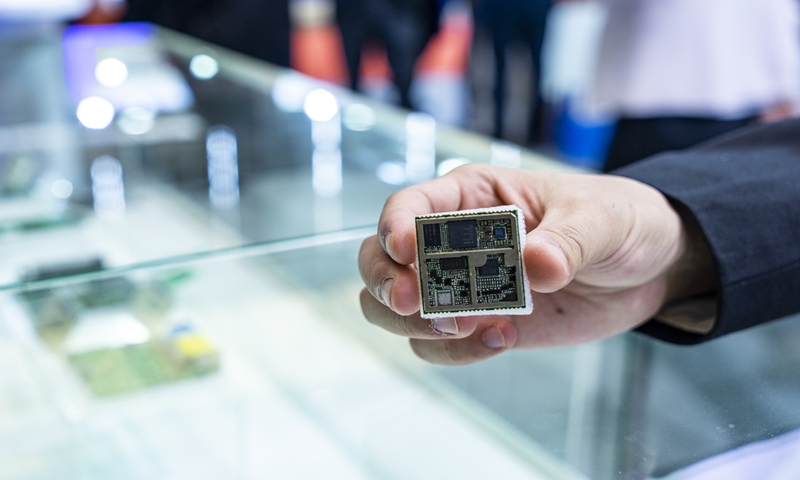COMMENTS / EXPERT ASSESSMENT
Industrial restructuring due to chip shortage offers opportunity for Chinese firms

An employee showcases a semiconductor integrated circuit at an industry expo. Photo: VCG
The devastating resurgence of COVID-19 across the Southeast Asian region has disrupted many local manufacturing sectors, clouding the recovery of global production. The global shortage crisis of microchips is no exception, with a new blow dealt as one leading Malaysian manufacturer temporarily shut down some of its factories amid a new wave of infection.
The semiconductor firm Unisem Bhd, one of several large Malaysian-based chip assemblers and testers, will shut some plants for seven days after three employees died recently from COVID-19, dealing a fresh blow to the chip supplies that carmakers and other companies rely on, Bloomberg reported on Wednesday.
Though Southeast Asian semiconductor firms are mainly at the low end of the industrial chain, they still play a crucial role as the chip industry has developed a highly refined international division of labor. The Southeast Asian region, as a whole, accounts for about 27 percent of global semiconductor packaging and testing.
Malaysia has become the seventh largest semiconductor export hub in the world, accounting for 13 percent of global semiconductor packaging and testing. More than 50 semiconductor multinationals have invested in Malaysia, which covers almost all the major semiconductor companies across the world, according to media reports.
However, the Southeast Asian region since late March has emerged a new wave of infection of the Delta variant of the novel coronavirus. According the data from the World Health Organization, Southeast Asia has become the region reporting the third largest number of confirmed infection cases at over 41.8 million, after Americas and Europe.
Malaysia’s average daily confirmed cases during the past seven days were recorded at around 20,000, with Vietnam’s reaching over 12,000.
It appears hard for countries in the region to roll out a strict prevention measures as tourism is one of the pillars for most of the Southeast Asian economies. But without strict prevention policies, domestic manufacturing remains vulnerable.
Given the uncertainty across the region caused by the pandemic, the global semiconductor industrial chain, which has already hammered by the virus, may further speed up restructuring from “single-axis” to “multi-axis” patterns. The industry’s former highly refined division of labor across the world will be narrowed down to regions or even within one country, forming several independent industrial chains in the world.
Given this changing landscape, China, with its advantages in manufacturing and huge market, is expected to shape up a complete chip industrial chain in a faster pace. It is also in line with China’s own pace cultivating an independent approach of high-tech development.
Moreover, as a cyclical industry, the semiconductor sector is believed to see rising fluctuation due to the multiple blows brought about by the pandemic. Global chip producers have ratcheted up efforts to expand production to meet demand over the recent months; once the crisis eases, it is expected that a large number of firms will face a life-and-death struggle dealing with surplus production capacity and unused inventory.
It is true especially for small firms, mergers and acquisitions are likely to become increasingly common which would be an opportunity for investors from Chinese mainland. Though the US-led anti-China forces have been attempting to contain China’s technology advancement, the high-tech sectors are still capital-driven industries. Now such an opportunity may have been shortened this new horizon considerably.
The article was compiled based on an interview with Ma Jihua, a veteran industry analyst. bizopinion@globaltimes.com.cn
